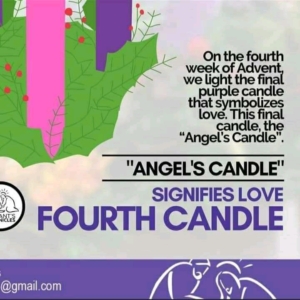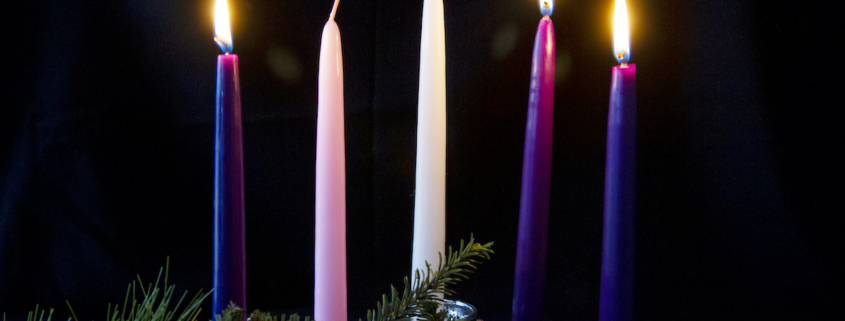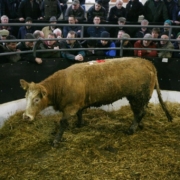Advent

THE 4 WEEKS OF ADVENT – THE CANDLES AND THE WREATH
Advent is celebrated four consecutive weeks before Christmas.With the season of Advent, starts the lighting of different candles.
Traditionally, each of the five Advent candles have a deeper meaning which is depicted in the four weeks we celebrate this season of waiting, watching and expecting Jesus.
Here’s the specific meaning of the four weeks of Advent:
WEEK 1
The 1st Sunday of Advent symbolizes HOPE with the “PROPHET’S CANDLE ” reminding us that Jesus is coming. (Purple Candle)
The first week of this Advent reminds us of the coming of Jesus Christ the Redeemer. The first week marked with a purple candle has the meaning of HOPE. We all look forward to Christ’s coming full of joy and hope.
The first candle this week is called the Candle of the Prophet who reminds us that the coming of Jesus as Messiah has been preached by the prophets.
And again, Isaiah says,
“The Root of Jesse will spring up,
one who will arise to rule over the nations;
in him the Gentiles will hope.”
(Isaiah 11:10)
WEEK 2
The 2nd Sunday of Advent symbolizes FAITH with the “BETHLEHEM CANDLE ” reminding us of Mary and Joseph’s journey to Bethlehem. (Purple Candle)
The second week of Advent has the meaning of FAITH and LOVE. In this second week the second purple candle is lit, reminding us to remain faithful to prepare the way for the coming of the Lord. We are required to prepare our hearts and love for the coming of Christ.
The second candle is called the Bethlehem Wax which means that our Savior Jesus Christ will be born in our hearts.
As it is written in the book of the words of Isaiah the prophet:
“A voice of one calling in the wilderness,
‘Prepare the way for the Lord,
make straight paths for him.
Every valley shall be filled in,
every mountain and hill made low.
The crooked roads shall become straight,
the rough ways smooth.
And all people will see God’s salvation.”
(Luke 3: 4-6)
WEEK 3
The 3rd Sunday of Advent symbolizes JOY with the “SHEPHERD’S CANDLE ” reminding us of the Joy the world experienced at the coming birth of Jesus. (Pink Candle)
The third week of Advent is marked by two purple candle bars and one pink candle. This third week reminds us of JOY. We are together delighted to welcome the birth of Jesus our Savior.
The third candle is called the Shepherds Candle because the news of joy about the birth of Jesus Christ was first communicated to humble and sincere people.The rose candle is lit on the third Sunday, Gaudete Sunday, when the priest also wears rose vestments at Mass; Gaudete Sunday is the Sunday of rejoicing, because the faithful have arrived at the midpoint of Advent, when their preparation is now half over and they are close to Christmas.
But the angel said to them, “Do not be afraid. I bring you good news that will cause great joy for all the people.”
(Luke 2:10)
WEEK 4
The 4th Sunday of Advent symbolizes Peace with the “ANGEL’S CANDLE ” reminding us of the message of the angels: “Peace on Earth, Good Will Toward Men.” (Purple Candle)
This is the last week of Advent. The fourth week of special significance PEACE is characterized by three purple candle bars and one pink candle.
The fourth week of Advent reminds us of the glory of God, the owner of the universe. Together we rejoice in His coming.
The fourth candle is called the Angel Candle that symbolizes happiness and joy to welcome the Savior.
“Glory to God in the highest heaven, and on earth peace to those on whom his favor rests.”
(Luke 2:14)
WHITE CANDLE OR THE CHRIST CANDLE
The fifth candle which is placed at the center of the wreath is called the “CHRIST CANDLE” which reminds us of Jesus who is at the center of the season. It is lit on Christmas Eve. Jesus alone is the reason why we celebrate Christmas. (White Candle)
White is the color of Advent representing purity and light. Christ is the sinless, spotless, pure Savior. He is the light come into a dark and dying world. Also, those who receive Jesus Christ as Savior are washed of their sins and made whiter than snow.
The Christ Candle is the fifth Advent Candle, positioned in the center of the wreath. This Advent Candle’s color is white. It is lit on Christmas Eve as a remembrance of Christ coming into the world.
THE WREATH
The Advent wreath first appeared in Germany in 1839. Lutheran minister Johann Hinrich Wichern working at a mission for children created a wreath out of the wheel of a cart. He placed twenty small red candles and four large white candles inside the ring. The red candles were lit on weekdays and the four white candles were lit on Sundays.
The Advent wreath, which has German origins, is probably the most recognized Advent custom. It is a wreath made of evergreens that is bound to a circle of wire.
The evergreens used for the wreath itself are a reminder of continuous life. The shaping of them into a circle reinforces that meaning.
The circle is also a sign of everlasting life as well as the eternity of God.It symbolizes the many years from Adam to Christ in which the world awaited its Redeemer; it also represents the years that we have awaited His second and final coming.
The wreath holds four equally spaced candles, the three purple ones lit on the penitential Sundays and a pink one for Gaudete, the joyful third Sunday in Advent.The seedpods, nuts and pinecones used to decorate the wreath are symbolic of resurrection, and fruits represent the nourishing fruitfulness of the Christian life.
Additional decorations, like holly and berries, are sometimes added. Their red color points ahead to Jesus’ sacrifice and death on the cross, shedding his blood for our sins.
The laurel signifies victory over persecution and suffering; pine, holly, and yew, immortality; and cedar, strength and healing. Holly also has a special Christian symbolism: The prickly leaves remind us of the crown of thorns, and one English legend tells of how the cross was made of holly.


 William G. Henry & Co., Solicitors
William G. Henry & Co., Solicitors Stewart Fuel Oils, Boyle
Stewart Fuel Oils, Boyle








